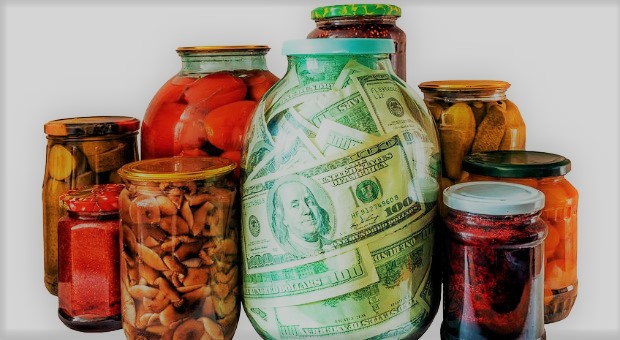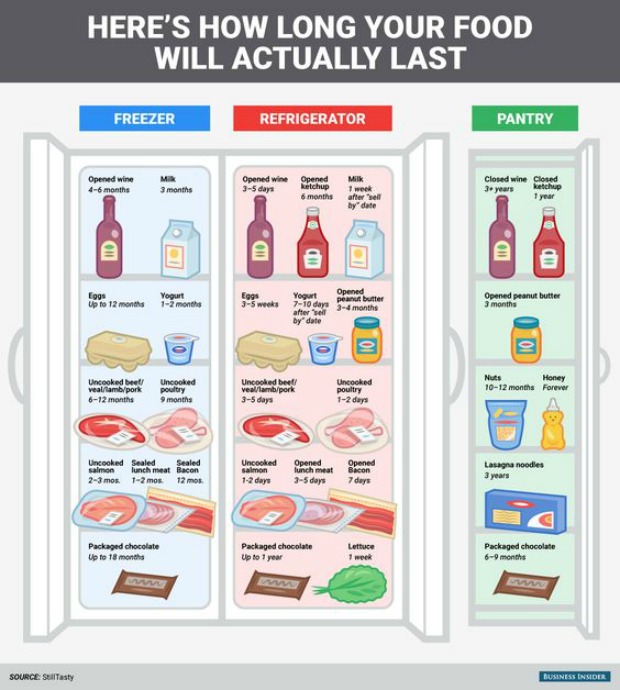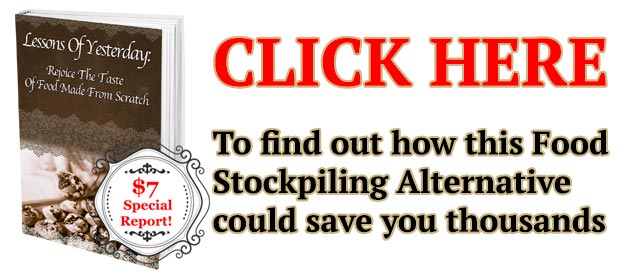Remember when Mom or Grandma would send you to the pantry or down to the basement to grab another jar of pickles or peanut butter?
There were probably at least a couple of extra jars behind the one that you grabbed. That’s because they lived through times when having backup food meant the difference between eating and going hungry. They had it “just in case.” Do you practice this? If not, you should.
We live in unsure times. The United States economy is by far the largest in the world; more than twice that of China, the world’s second largest economy. US money and goods support the global economy to the point that if we suffer an economic collapse, we take the rest of the world down with us.
But there’s one solid way to hedge your future – a basic commodity that everybody will always need: food.
Considering the state of the nation right now, an economic collapse is just as likely as not – maybe even more likely. The crazy explosion in the US monetary system and the instability of our government doesn’t just make it possible that we’ll face hyperinflation in the near future – it practically guarantees it.
Food costs are going to keep increasing and in the case of an economic collapse, will quickly increase to the point that foods that are barely affordable to many households now, such as meat, will be completely out of reach. The price of many “affordable” foods such as sauces, pasta, rice, sugar and flour will likely increase to the point that they’ll barely be affordable, assuming they’re available.
Until recently, the primary concern for most of us was economic collapse, with governmental collapse being a peripheral concern. Now, in these uncertain times, either – or both – is increasingly likely. Both would bring about life-altering circumstances that would dethrone the current money-based system in favor of a barter system.
Guess what that does to all those stocks, bonds, and savings accounts (and for that matter, cash) when that happens: they become worthless. But do you know what gains value exponentially? Food. And to a lesser extent, hygiene products. Investing in both will give you the tools you need to barter, survive, and even thrive.
No matter how poor somebody is, they’ll always need to eat. That doesn’t mean that you should gouge them. It just means that you’ll have a commodity that will be of value to everybody.
So, investing in food is the way to go. Even if you only invest in it passively, without ever selling a single noodle of it, you’ll still be saving much more by buying food for tomorrow at today’s prices than many investments that most of us can afford would yield. The longer you eat food bought at today’s prices, the more money you’ll save.
Food costs, with the exception of fresh fruit, decreased for the first time in years from December of 2015 – December of 2016, but that isn’t anticipated to continue. The USDA anticipated a hike in 2017 based on stable conditions – in other words, before the political climate changed so radically. Essentially, you have the chance right now to buy at bargain basement prices and put off buying when the prices go up.
So, how do you invest in food? Well, there are several different ways, and you can do it, at least to a certain degree, no matter where you live or how much money you have.
Considerations to the Return on Your Investment
Unless you have a huge farm with numerous gardens and storage spaces, and a lot of money to feed livestock and grow fresh produce, you have some challenges. That’s OK. You just need to work with what you have and find a proper way to secure your future.
Discover the ingenious recipes that helped our ancestors stay alive!
Space
This is probably the biggest limitation that you may face. If you live in a 1-bedroom apartment in an urban environment, the only space you may have is a closet and some cabinets. That’s fine. Make the most of what space you have by stockpiling a variety of staple foods and hygiene items.
Even the cabinet under your bathroom sink will hold more hygiene products than you might think. The more you can buy now at a lower price, the more you’ll save. Utilize your space well, buying products that you’ll use, and that will last.
Shelf Life
No matter how much space you have, shelf life is always a consideration. If you buy enough food to meet your needs for five years but it expires in two, you’ve wasted your resources.
Allocate your money responsibly and with forethought. Know how much you and your household eat monthly/annually. Use the FIFO (First In, First Out) method and store food in a way that will preserve it for as long as possible.
What Types of Food You Can Store
While you can save a ton of money on buying extra boxes of cereal and jars of peanut butter, there are some types of foods that will save you more than others.
For instance, meat, eggs, and dairy prices are anticipated to increase significantly more than cabinet foods but they don’t have much of a shelf-life. Consider your resources and storage capabilities when you plan your shopping.
Methods to Help You Invest in Food
Now that you know what you need to consider when you’re investing in food, let’s talk about ways to help you invest better so that you get the most bang for your buck.
1. Buy a Freezer
Milk, meat, and eggs just aren’t shelf-stable as-is, but they’re the top foods that increase quickly in cost. You do have some options. All of these products have canned or powdered options that have excellent shelf lives.
You can also can your own meat and butter, and you can buy a freezer to store up to a year’s worth of food. Believe it or not, all dairy is freezable.
Many people are worried about lack of electricity in the event of a collapse and avoid freezers, but the odds of complete electric failure are pretty slim if you have an alternative power source. Most meats and dairy store frozen for up to six months, or even a year. Also the cost of a freezer, if you have a proper place where you can put one, will be covered by the savings in a short time.
2. Build a Food Storage Space
If you have the space, build or buy an extra food/supply shed. The money that you save in food and necessaries will pay for it in very little time.
3. Use Coupons and Sales
If you combine coupons and sales, you’ll be amazed how quickly you can build a stockpile for next to nothing. It’s a matter of paying attention to what’s on sale.
For instance, today I bought 6 bottles each of ketchup, shampoo, and laundry detergent for $13 total. My total savings was $24. And that doesn’t even count what I’ll save by not buying later when the price is higher.
All three are products that I use and that would be valuable if something happens and I need to barter, so there’s no way I can lose.
4. Buy Popular, Necessary Products
There are some foods and products that everybody just has to have. Examples: flour, green beans, tampons, deodorant, etc. Don’t buy a ton of lima beans if they’re on sale unless you really love them because they’re not a popular food. Sometimes there’s a reason things are on clearance – nobody else wanted to buy it!
Also, if you’re preparing for a bartering situation, alcohol and tobacco are going to be premium, in-demand products. Cigarettes are brutally expensive, but loose tobacco and rolling papers are fairly inexpensive and, as long as they’re sealed in air-tight containers, have a long shelf-life.
Regarding alcohol, remember that it’s not just for drinking – you can make tinctures and clean wounds and first-aid tools with it, too. Having extra vodka or bourbon is never a bad thing.
5. Buy Healthy Products
For some reason, people seem to want to pile in the boxes of cookies and cans of spaghetti-o’s because they’re cheap and delicious, but have no (or little) dried eggs, milk, canned meats, or meal stretchers such as flour and rice.
Think healthy. It’s important that you buy foods that you like – and cheap is good, too – but remember that you may be depending on your stockpile for survival. Stock up with healthy foods, too.
Also, canned milk, eggs, flour, rice, and other similar products are extremely versatile. You can eat or drink them as-is, or you can use them in recipes to make other products such as bread, cakes, side dishes, etc.
6. Buy in Bulk
This is our final point today, and it’s a big one because you may not need 20 pounds of flour or sugar now, but will you use it eventually? Of course you will, and it really doesn’t go bad as long as it’s stored properly.
A 20-pound bag of sugar often costs only a few bucks more than a 5-pound bag. Same with sugar. Compare cost per unit instead of just thinking of one being more expensive than the other. Dollars to donuts, bulk is almost guaranteed to be cheaper than smaller portions.
Now that you have some ideas about how to invest in food, start planning, then start buying. You can have a great stockpile built up in no time even if you just buy stuff that’s on sale buy-one-get-one-free and put back the extra. It adds up quickly, and you’ll have a nice nest egg sitting in your pantry or basement!
Preppers do have options for investing in food as the ultimate survival backup, and one of them is available right here.
Find how our forefathers handled their survival food.
Click the banner below and uncover their secrets for your own survival!
This article has been written by Theresa Crouse for Survivopedia.











hillbilly girl | February 23, 2017
|
Cut back on eating out. If you save $30.00 or more per week on eating out, you can buy a lot of food. Too tired to cook? Do a ‘heat and eat’ meal. After getting some basics, use some of the savings to pay for powdered eggs, etc. If you know you will be coming home late, cook an extra large meal a day or two in advance. When you get home, enjoy the leftovers! We did that tonight.
Deb | April 26, 2017
|
Exactly, what cooked meats can I put in vacuum sealed bags?
Pingback:How To DIY An Expensive Water Filter On A Budget | Survivopedia | February 15, 2018
|